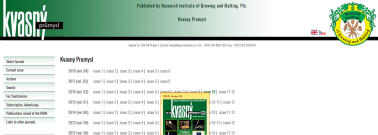Sensory analysis of malt
DOI:
https://doi.org/10.18832/kp2022.68.628Keywords:
malt, colouring sunstances, flavour substances, aroma substances, sensory analysisAbstract
Various malts are suitable for the production of a certain type of beer, which can also be selected on the basis of their sensory properties. Sensory evaluation of malts is part of the development of sensory tools (maps) used in malting and brewing practice. Malt, as the main raw material, brings a large amount of sensorially active substances into beer, as well as precursors of other aromatic and taste-important substances that are created during beer production technology. The Maillard reaction is the basis for the production of aroma and colour of malts. Reducing sugars together with amino acids create high molecular weight pigments, melanoidins, which are the carriers of the brown colour of malts. At the same time, important desirable sensory active compounds are formed which give the characteristic colour, flavour and aroma to the malt. The enhancement of some special characteristics of malts is achieved by modifying the technology of the malting process, especially by increasing the temperature. The results of the sensory analysis of malt can be applied in the selection of suitable raw materials for beer production or the development of new beer recipes with predictable sensory properties.
References
Basařová, G. et al. (2015). Sladařství: Teorie a praxe výroby sladu. Havlíček Brain Team, Prague, pp. 648. ISBN 978-80-87109-47-2
Beal, A. D., Mottram, D. S.: J (1994). Compounds contributing to the characteristic aroma of malted barley. Journal of Agriculture and Food Chemistry, 42(12), 2880–2884. https://doi.org/10.1021/jf00048a043
Buhr, K., Pammer, C., Schieberle, P. (2010). Influence of water on the generation of Strecker aldehydes from dry processed foods. European Food Research and Technology, 230, 375. https://doi.org/10.1007/s00217-009-1169-y
Cejpek, K. (2014). Vonné a chuťové složky sladů. Chemické Listy, 108, 426–435.
Coghe, S., Benoot, K., Delvaux, F., Vanderhaegen, B., Delvaux, F. R. (2004). Ferulic acid release and 4-vinylguaiacol formation during brewing and fermentation: indications for feruloyl esterase activity in Saccharomyces cerevisiae. Journal of Agriculture and Food Chemistry, 52(3), 602–608. https://doi.org/10.1021/jf0346556
Czech Accreditation Institute (2018). Dokument EA-4/09 G.2017 Accreditation For Sensory Testing Laboratories. In: www.cai.cz [online, cited 01-07-2022]. Available from: https://www.cai.cz/wp-content/uploads/2019/02/01_08-P006_EA_04_09_G_201801181.pdf
da Costa, M. S., Gonçalves, C., Ferreira, A., Ibsen, C., Guedes de Pinho, P., Silva Ferreira, A. C. (2004). Further insights into the role of methional and phenylacetaldehyde in lager beer flavor stability. Journal of Agriculture and Food Chemistry, 52(26), 7911–7917. https://doi.org/10.1021/jf049178l
Damm, E., Kringstad, H. (1964). Volatile carbonyl compounds in barely and malts. Journal of the Institute of Brewing, 70(1), 38–42. https://doi.org/10.1002/j.2050-0416.1964.tb01964.x
DraughtLab (2017a). Base Malt Flavour Map. https://craftmalting.com/product/malt-sensory-map/
DraughtLab (2017b). Specialty Malt Flavour Map. https://craftmalting.com/product/specialty-malt-flavor-map/
EBC 4.7.2 (2009). Colour of Malt: Visual Method. In: EBC Analysis Committee-Nürnberg (ed.). Analytica EBC, Hans Carl Get-ränke Fachverlag, Chap. 4.7.2.
EBC 5.6 (2009). Coloured Malts: Colour, Visual Method. In: EBC Analysis Committee-Nürnberg (ed.). Analytica EBC, Hans Carl Get-ränke Fachverlag, Chap. 5.6.
Frank, O., Ottinger, H., Hofmann, T. (2001). Characterization of an intense bitter-tasting 1H,4H-quinolizinium-7-olate by application of the taste dilution analysis, a novel bioassay for the screening and identification of taste-active compounds in food. Journal of Agriculture and Food Chemistry, 49(1), 231–238. https://doi.org/10.1021/jf0010073
Ježek, F., Saláková, A. (2012). Senzorická analýza potravin. Veterinary and Pharmaceutical University, Brno. Available from: https://fvhe.vfu.cz/files/skripta-senzorika_2012.pdf
Kishnani, P., Barr, L., Speers, A.(2022). Evaluation of dimethyl sulfide thresholds. Journal of the American Society of Brewing Chemists, 80(2), 109–111. https://doi.org/10.1080/03610470.2021.1945852
Maarse, H., Vissher, C. A., Willemsens, L. G., Nijssen, L. M., Boelens, M. H. (1996). Volatile compounds in food: Qualitative and quantitative data (7th ed.). TNO Nutrition and Food Research Institute, pp. 2350. ISBN 9789067434133
Mackie, A. E., Slaughter, J. C. (2000). The contribution of 4‐hydroxyfuranone derivatives to the aroma of commercial beers and malts. Journal of the Institute of Brewing, 106(4), 209–214. https://doi.org/10.1002/j.2050-0416.2000.tb00059.x
Voigt, J. (2018). Malt aroma research—Analytical and sensorial approaches. MALT IS EVERYTHING… when it comes to beer. 10.–13. June 2018, Roseville, Minnesota, USA.
Olšovská, J., Čejka, P., Štěrba, K., Slabý, M., Frantík, F. (2017). Senzorická analýza piva. Research Institute of Brewing and Malting, Prague, pp. 146. ISBN 978-80-86576-74-9.
Ottinger, H., Soldo, T., Hofmann, T. (2001). Systematic studies on structure and physiological activity of cyclic α-keto enamines, a novel class of “cooling” compounds. Journal of Agriculture and Food Chemistry, 49(11), 5383 – 5390. https://doi.org/10.1021/jf010857v
Prado, R., Gastl., M., Becker, T. (2021). Aroma and color development during the production of specialty malts: A review. Comprehensive Reviews in Food Science and Food Safety, 20(5), 4816–4840. https://doi.org/10.1111/1541-4337.12806
Rychlik, M., Schieberle, P., Grosch, W.(1998). Compilation of odor thresholds, odor qualities and retention indices of key food odorants. Institut für Lebensmittelchemie, TU München, pp. 63. ISBN 9783980342650
Smith, B. (2017) Sensory Evaluation of Grains for Brewing – The New ASBC Method. In: beersmith.com [online, cited 03-07-2022]. Available from: https://beersmith.com/blog/2017/06/23/sensory-evaluation-of-grains-for-brewing-the-new-asbc-method/
Su, X., Yu, M., Wu, S., Ma, M., Su, H., Guo, F., Bian, Q., Du, T. (2022). Sensory lexicon and aroma volatiles analysis of brewing malt. npj Science of Food, 6, 20. Available from: https://doi.org/10.1038/s41538-022-00135-5
Vandecan, S.M.G., Saison, D., Schouppe, N., Delvaux, F., Delvaux, F.R. (2010). Optimisation of specialty malt volatile analysis by headspace solid-phase microextraction in combination with gas chromatography and mass spectrometry. Analytica Chimica Acta, 671(1–2), 55–60. https://doi.org/10.1016/j.aca.2010.05.009
Velisek, J. (2014). The Chemistry of Food. Wiley-Blackwell, New York, pp. 1124. 2014. ISBN 978-1-118-38381-0
Wimmer, Z., Opletal, L., Čopíková, J., Moravcová, J., Abdulmanea, K.S.O., Lapčík, O., Drašar, P. (2012). Kovová chuť přírodních látek a jejich derivátů. Chemicke Listy, 106(10), 926–930. Available from: http://www.chemicke-listy.cz/ojs3/index.php/chemicke-listy/article/view/833
Windes, S., Bettenhausen, H.M., Van Simaeys, K.R., Clawson, J., Fisk, S., Heuberger, A.L., Lim, J., Queisser, S.H., Shellhammer, T.H., Hayes P.M. (2021). Comprehensive analysis of different contemporary barely genotypes enhances and expands the scope of barley contributions to beer flavor. Journal of the American Society of Brewing Chemists, 79(3), 281–305. https://doi.org/10.1080/03610470.2020.1843964
Woffenden, H.M., Ames, J.M., Chandra, S. (2001). Relationships between antioxidant activity, color, and flavor compounds of crystal malt extracts. Journal of Agriculture and Food Chemistry, 49(11), 5524–5530. https://doi.org/10.1021/jf010583b

Downloads
Published
How to Cite
Issue
Section
License
Copyright (c) 2022 Zdeněk Svoboda, Ivo Hartman, Sylvie Běláková, Marek Pernica, Rastislav Boško, Karolína Benešová

This work is licensed under a Creative Commons Attribution 4.0 International License.







